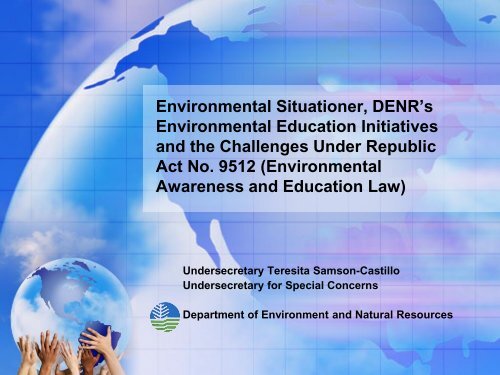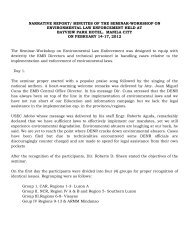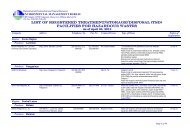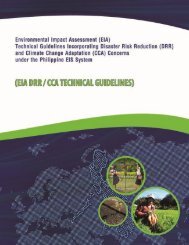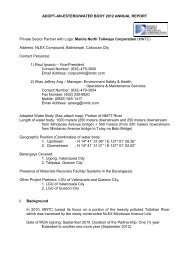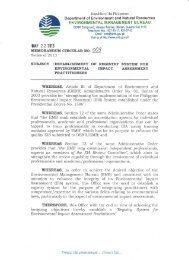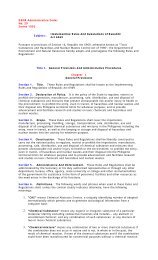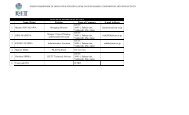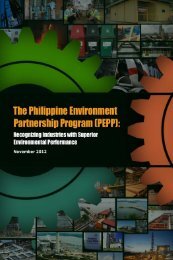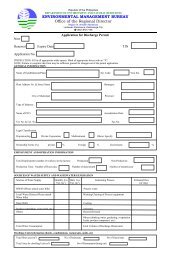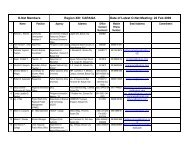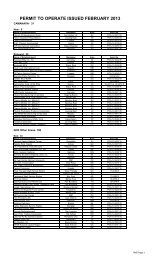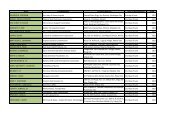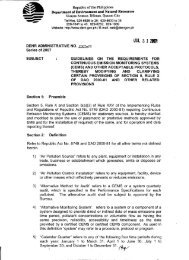Environmental Situationer, DENR's Environmental Education ...
Environmental Situationer, DENR's Environmental Education ...
Environmental Situationer, DENR's Environmental Education ...
You also want an ePaper? Increase the reach of your titles
YUMPU automatically turns print PDFs into web optimized ePapers that Google loves.
<strong>Environmental</strong> <strong>Situationer</strong>, DENR’s<strong>Environmental</strong> <strong>Education</strong> Initiativesand the Challenges Under RepublicAct No. 9512 (<strong>Environmental</strong>Awareness and <strong>Education</strong> Law)Undersecretary Teresita Samson-CastilloUndersecretary for Special ConcernsDepartment of Environment and Natural Resources
The State of Environment• One of 17 mega-diverse countries in theworld Containing two-thirds of the earth’s biodiversity 70-80% of the world’s endangered species
The State of EnvironmentThe State of Environment• 4 th in the World in bird endemism• 5 th in the World in mammal endemism• 5 th in the World in number of plant species• 8 th in the World in reptile endemism
The State of EnvironmentPuerto Princesa Subterranean River NationalParkMayon VolcanoChocolate HillsTubbataha ReefCandidates fortheNEW 7WONDERS OFTHE WORLD
The State of EnvironmentVerde Island Passage Marine Corridor(Sulu-Sulawesi Marine Ecoregion)Center of the center of marine shorefish diversityin the world
Philippine Water ResourcesWater Supply = 146.0 Bcu.mWater Consumption = 40.9 Bcu.mConsumption Ratio = 28.0%The State of EnvironmentThe State of Environment
The State of EnvironmentThe State of Environment• One of the hottest ‘hot spots’ inhabitat destruction
The State of Environment• Massive loss of forest cover now down toonly about 18% of our total land area• Only about 800,000 hectares of virginforest left
The ScenarioThe State of Environment• Threatened and endangered species (increasing inabout 9.7% annually)• Only 5% of our coral reefs remain in excellent condition• 30-50% of our seagrass beds were lost in the last 50years• Only 112,400 hectares of mangroves left (decline from450,000 ha in 1918 to less than 120,000 in 1995)
The ScenarioThe State of Environment• The degradation of coastal and marine ecosystemhas affected fish production• Catch per municipal fisherman significantly wentdown from about 1500 kg per year in 1987 to about1100 kg per year in 1996
The Scenario• Groundwater levels going down by 5-10 meters forthe last several decades that led to saline intrusionand ground subsidence• Sixteen major rivers, five in Metro Manila, arebiologically-dead during summer months due topollution• 48% of water pollution is caused by householdwaste, compounded by the lack of an adequatesewerage system
The ScenarioThe State of Environment• TSP levels above the standards by as much as200% adverse health impacts
The Scenario• In 2000, 76M Filipinos generated over 10million tons of municipal solid wastes.• In 2007, waste projection is at 12.45 milliontons.• On 2012, waste projection is pegged at 14million tons (13.83 million tons to be exact)
…Global catastrophes are happeningAnd will continue to happen…
United Nations Decade of <strong>Education</strong> forSustainable Development (2005-2014)Photo Credit: UNESCO ESDVisionA world where everyone has the opportunityto benefit from education and learn thevalues, behaviours, and lifestyles required fora sustainable future and for positive societaltransformation.
Decade of <strong>Education</strong> for SustainableDevelopment (DESD)Objectives• Facilitate networking, linkages, exchange, andinteraction among stakeholders in ESD• Foster an increased quality of teaching andlearning in <strong>Education</strong> for SustainableDevelopment• Help countries make progress toward and attainthe Millennium Development Goals (MDGs)through ESD efforts• Provide countries with new opportunities toincorporate ESD into education reform efforts
What is <strong>Education</strong> for Sustainable Development?Photo Credit: dhss.mo.govESD uses a partnership approach thatengages multiple sectors and stakeholders –including media and the private sector – andutilises all forms and methods of publicawareness-raising, education, and training topromote an appreciation for, even awelcoming of, sustainable development.
The ASEAN <strong>Environmental</strong><strong>Education</strong> Action Plan (2008-2012)Theme:<strong>Environmental</strong> <strong>Education</strong> for SustainableDevelopmentAim:Accelerate EE as a key integrating componentfor achieving SD in the ASEAN membercountries.
The AEEAP Mission StatementThe ASEAN member-countries, envision a cleanand green ASEAN, rich in cultural traditions(where the values and practices of the people arein accord with the rhythm and harmony of nature)with citizens who are environmentally literate,imbued with environmental ethic, willing andcapable to ensure the sustainable development ofthe region, through EE and public participationefforts.
National <strong>Environmental</strong> <strong>Education</strong>Action Plan (NEEAP)Photo Credit: jooc.com• Philippine initiative to the United NationsDecade of <strong>Education</strong> for SustainableDevelopment (2005-2014) and the ASEAN<strong>Environmental</strong> <strong>Education</strong> Action Plan• The aim is to pursue education to foster thetransition to a sustainable society.
National <strong>Environmental</strong> <strong>Education</strong> Action Planfor Sustainable Development (2005-2014)VisionAn environmentally literate and proactive citizenryimbued with a sense of responsibility to care,protect and enhance environmental quality that isconducive to their well being and supportive of thenation’s economic development and unified in itspursuit of peace, social justice and equity in theuse of natural resources.
National <strong>Environmental</strong> <strong>Education</strong> Action Planfor Sustainable Development (2005-2014)Mission- To improve the institutional systems, makingthem more relevant towards delivery ofenvironmental education to all segments ofsociety.- To mobilize resources and encourage moreprivate/public investments and partnerships insupporting programs for environmentaleducation.
The Major Recent Milestonesin <strong>Environmental</strong> <strong>Education</strong>United Nations Decade of <strong>Education</strong> forSustainable Development (2005-2014)ASEAN <strong>Environmental</strong> <strong>Education</strong> ActionPlan (2008-2012)National <strong>Environmental</strong> <strong>Education</strong> ActionPlan (2005-2014)Republic Act 9512 (An Act to Promote<strong>Environmental</strong> Awareness through<strong>Environmental</strong> <strong>Education</strong>)2008
<strong>Environmental</strong> <strong>Education</strong>Rationalemmmmm• R.A. 9512: "<strong>Environmental</strong> Awarenessand <strong>Education</strong> Act of 2008"The state shall promote national awareness on therole of natural resources in economic growth and theimportance of environmental conservation andecological balance towards sustained nationaldevelopment.
<strong>Environmental</strong> <strong>Education</strong>Rationalemmmmm• R.A. 9512: "<strong>Environmental</strong> Awareness and <strong>Education</strong> Act of 2008"Strengthen the integration of environmental education towardssustainable development in the Philippines (for all levels andsectors) thru :- Curriculum- <strong>Education</strong>al Materials- Training and Capacity Building for Educators/Trainers- Institutionalization
RESPONSIBLE CENTERSDepEd, CHED, TESDA, DENR and DOST• Lead the implementation of public education andawareness programs on environmental protection andconservationDENR• Inform all agencies concerned on current environmental updatesincluding identification of priority environmental education issuesfor national action• Provide strategic advice on environmental education activitiesDOST• Create programs that will ensure that students receivescience-based quality information on environmental issuesSTRATEGY: Collaborative Inter-Agency and Multi-Sectoral Effort
Highlights of DENR’sPrograms and Initiatives on<strong>Environmental</strong> <strong>Education</strong> forSustainable Development
National <strong>Environmental</strong> <strong>Education</strong> Action Planfor Sustainable Development (2005-2014)• Multi-stakeholder development of the National<strong>Environmental</strong> <strong>Education</strong> Action Plan forSustainable Development (2005-2014), withannual conferences on <strong>Environmental</strong><strong>Education</strong> since 2004.
National <strong>Environmental</strong> <strong>Education</strong> Action Planfor Sustainable Development (2005-2014)Materials development activities onvarious aspects of environment andnatural resources management:• instructional posters• videos, television and radio plugs
National <strong>Environmental</strong> <strong>Education</strong> Action Planfor Sustainable Development (2005-2014)• Modules, manuals, and guidebooks• Environment and Natural Resources Module forthe Civic Welfare Training Service of theNational Service Training Program• Fact sheets and brochures• Newsletters and Journals• Brochures and pamphlets
National <strong>Environmental</strong> <strong>Education</strong> Action Planfor Sustainable Development (2005-2014)Spearheaded linkaging with various educationalnetworks:• Philippine Association of Tertiary Level <strong>Education</strong>alInstitutions in <strong>Environmental</strong> Protection andManagement (PATLEPAM),• Catholic <strong>Education</strong>al Association of the Philippines• Philippine Association of Colleges and Universitiesfor conferences, workshops, trainings,consultations
National <strong>Environmental</strong> <strong>Education</strong> Action Planfor Sustainable Development (2005-2014)• Conduct of year-round mobilization of sectorsduring national and international environmentalcelebrations and events
The DENR Youth DeskEco-Corps• To give environmentalism a major niche at thetertiary level of the National Service TrainingProgram (NSTP), the DENR and PATLEPAM hascome up with eight (8) environmental moduleswhich will become part of NSTP's Civic WelfareTraining Services.
The DENR Youth DeskEco-Corps• Known as "Eco-Corp," the modules area collection of 52 hours of lectures andhands-on exercises on community workthat revolve on various environmentalconcerns. The modules are presentlyundergoing pre-testing in variousuniversities.
The DENR Youth DeskYES Camp• Now on its 6th year, the Youth For EnvironmentSummer Camp is jointly conducted for Studentsand DepEd Students and Co-Curricular Affairs,KASAMA Inc. and DENR Youth Desk heldthroughout the country involving elementary, highschool students and science teachers.• YES CAMP College 2008 is a partnership withthe Office of Student Services, Commission onHigher <strong>Education</strong>.
The DENR Youth DeskYES Camp• DepEd Order No. 72, series of 2003, establishesYES-O as the only co-curricular environmentalclub or organization in schools.• It consolidates all other environmental and/orecology clubs or organizations in schools withmain and primary programs or projects for theenvironment.
<strong>Environmental</strong> Activities Targeting the Youth• National Search for Sustainable and EcofriendlySchools in coordination with DepEd,CHED, and SMART Communications• Awarding will be held on November 2009, incelebration of the <strong>Environmental</strong> AwarenessMonth
<strong>Environmental</strong><strong>Education</strong> Materials
Modules and Guidebooks
Brochures
Fact sheets
Posters
Poster Calendars
Poster Calendars
Newsletters
State of the Environment Reports
Videos and TV Plugs
Challenges in<strong>Environmental</strong> <strong>Education</strong>• Maintenance of a common resource facility forenvironmental IEC exchange, and link with theASEAN <strong>Environmental</strong> <strong>Education</strong> InventoryDatabase• Training of Teachers or Trainers on<strong>Environmental</strong> <strong>Education</strong>/<strong>Education</strong> forSustainable Development
Challenges in<strong>Environmental</strong> <strong>Education</strong>• Curriculum, and Support Instructional MaterialsDevelopment on <strong>Environmental</strong> <strong>Education</strong> forSustainable Development• Full utilization of other venues (e.g. multi-mediaand alternative media) for <strong>Environmental</strong><strong>Education</strong>/<strong>Education</strong> for Sustainable Development
Challenges in<strong>Environmental</strong> <strong>Education</strong>• Strengthening of Partnerships and Networking for<strong>Environmental</strong> <strong>Education</strong>/<strong>Education</strong> forSustainable Development• Funds/financial support to expand <strong>Environmental</strong><strong>Education</strong>/<strong>Education</strong> for Sustainable Developmentprograms, particularly in the regions.
Thank you very much.Department of Environment and Natural ResourcesVisayas Ave. Diliman, Quezon Citywww.denr.gov.ph


